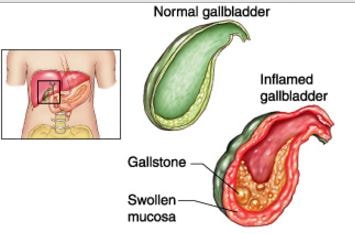Learn all about Acalculous cholecystitis symptoms, pathophysiology, causes and treatment options. Acalculous cholecystitis is the term for inflammation of the gallbladder that is not due to the presence of gallstones.
Most cases of acute cholecystitis (inflamed gallbladder) occur due to gallbladder stones (within the gallbladder) or biliary stones (lodged in the bile duct). In these cases it is referred to as calculous cholecystitis. Since it is so common, acute cholecystitis is considered to be synonymous with calculous cholecystitis. It is therefore important to differentiate acalculous cholecystitis specifically. Although it is less common, acalculous cholecystitis is associated with more serious complications, some of which can be life-threatening.
The mortality and morbidity of acalculous cholecystopathy are related to the invasive diagnostic tests that frequently are performed and to the treatment of the condition (i.e., cholecystectomy). Biliary dyskinesia does not progress to more serious conditions, such as acute cholecystitis. Laparoscopic cholecystectomy provides symptomatic relief in 90-95% of cases of biliary colic associated with gallstones. In contrast, despite appropriate patient selection, only approximately 80% of patients with acalculous cholecystopathy experience resolution of their symptoms.
Most patients with acalculous cholecystitis are critically ill, which makes the diagnosis challenging to make. Cholecystitis is but one of many potential causes of systemic inflammatory response syndrome or sepsis that may develop in such patients. Moreover, the differential diagnosis of jaundice in the critically ill patient is complex, and includes intrahepatic cholestasis from sepsis or drug toxicity and “fatty liver” induced by TPN, in addition to acalculous cholecystitis. Rapid and accurate diagnosis is essential, as ischemia can progress rapidly to gangrene and perforation.
The true incidence of acalculous cholecystopathy in the United States is unknown, although the condition occurs more frequently in females than males and in individuals aged 40-60 years. However, with the advent of laparoscopic cholecystectomy, data exist that suggest an increased rate of cholecystectomy. In general, 10-15% of patients undergoing laparoscopic cholecystectomy have biliary dyskinesia. Acute acalculous cholecystitis (AAC) can occur in young and middle-aged otherwise healthy individuals.
What is Acalculous cholecystitis
Acalculous cholecystitis refers to cholecystitis without gallstones. Acalculous Cholecystitis (ko-luh-sis-TIE-tis) is inflammation of the gallbladder. Your gallbladder is a small, pear-shaped organ on the right side of your abdomen, beneath your liver. The gallbladder holds a digestive fluid that’s released into your small intestine (bile).
Acalculous cholecystitis Symptoms
The symptoms of acalculous cholecystitis are largely the same as acute acalculous cholecystitis. Some of the symptoms are given below;
- Unexplained fever
- Abdominal distension
- Tenderness of the abdomen
- Abdominal discomfort or pain, usually in the right upper quadrant (RUQ)
- Elevated white blood cell count (leukocytosis)
- Vomiting, loss of appetite, weakness and malaise are non-specific symptoms of acute cholecystitis. In acalculous cholecystitis, these symptoms are more likely due to the underlying cause of gallbladder inflammation.
- Tachycardia
- Palpable gallbladder or fullness of the RUQ (30-40% of patients)
- Jaundice (~15% of patients)
- Acalculous cholecystitis Causes
Acalculous cholecystitis causes are as under; - Dengue fever
- Typhoid
- Sclerosing cholangiopathy
- Hepatitis B
- Hepatitis A
- Juvenile systemic lupus erythematosus
- Plasmodium falciparum
- Acute Epstein-Barr viral infection in a person with Gilbert syndrome
- Granular cell tumor of the common hepatic duct
- After cardiopulmonary resuscitation
Acalculous cholecystitis Treatment
Acalculous cholecystitis treatment depends on the severity of the condition and the presence or absence of complications.
- Cholecystectomy is most commonly performed using a tiny video camera mounted at the end of a flexible tube. This allows your surgeon to see inside your abdomen and to use special surgical tools to remove the gallbladder (laparoscopic cholecystectomy). The tools and camera are inserted through four incisions in your abdomen, and the surgeon watches a monitor during surgery to guide the tools. An open procedure, in which a long incision is made in your abdomen, is rarely required.
- Antibiotic therapy does not substitute for removal or drainage of acalculous cholecystitis, but remains an important adjunct. The most common bacteria isolated from bile in acute cholecystitis are E. coli, Klebsiella, and Enterococcus faecalis, thus antibiotic therapy should be directed against these organisms.
- The following medications may be useful in this setting:
- Levofloxacin and metronidazole for prophylactic antibiotic coverage against the most common organisms
- Antiemetics (e.g., promethazine or prochlorperazine) to control nausea and prevent fluid and electrolyte disorders
- Analgesics (e.g., oxycodone/acetaminophen)
Acalculous cholecystitis Pathophysiology
The main cause of acalculous cholecystitis is gallbladder stasis with resulting stagnant bile. The pathophysiology of acalculous cholecystitis is poorly understood, but it is probably multi-factorial. Functional cystic duct obstruction is often present and related to biliary sludge or bile inspissation caused by dehydration or bile stasis (due to trauma or systemic illness). Occasionally, extrinsic compression may play a role in the development of bile stasis. Some patients with sepsis may have direct gallbladder wall inflammation and localised or generalised tissue ischaemia without obstruction.
 Health & Care Information
Health & Care Information 


